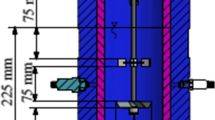Abstract
The kinetics of methane gas hydrate formation was obtained by different dual and dual mixed impeller experiments with surface baffle at 42.5 bars pressure and 2 °C temperature. The outcomes indicated that induction time is lower in radial flow experiments compared to mixed flow experiments due to better gas liquid contact, uniform shear stress and good pumping capacity compared to mixed flow ones with values less 15 min. Radial flow experiments showed higher values in hydrate yield although the duration of hydrate formation in radial flow experiments is less compared to mixed flow ones confirming the above outcomes with values more than 5%. Radial flow impellers indicated higher values in rate of hydrate formation compared to mixed flow impellers.






Similar content being viewed by others
References
Merey S, Longinos SN (2019) The gas hydrate potential of the Eastern Mediterranean Sea. Bull Miner Res Exp 160:117–134. https://doi.org/10.19111/bulletinofmre.502275
EIA (2019) Gas 2019 executive summary analysis and forecast to 2024. In U.S. Energy Information Administration, p. 3
Merey S, Longinos SN (2018) The role of natural gas hydrates during natural gas transportation. Ömer Halisdemir Üniversitesi Mühendislik Bilimleri Dergisi 7(2):937–953
Sloan ED (1998) Clathrate hydrates of natural gases. Marcel Dekker, New York
Longinos SN, Longinou DD, Achinas S (2020) Natural gas hydrates: possible environmental issues. Contemporary environmental issues and challenges in era of climate change. Springer, Singapore
Sloan ED, Koh CA (2008) Clathrate hydrates of natural gases. CRC Press, New York
Longinos S (2019) Potential environmental challenges for gas hydrates. LAP Lambert Academic Publishing, Beau Basin
Longinos SN, Bulbul S, Parlaktuna M (2019) Potential effects of methane hydrates to the environment, PESXM-12th Pan-Hellenic Scientific Conference in Chemical Engineering, Athens, Greece
Gudmundsson JS, Khodakar AA, Parlaktuna M (1994) Storing natural gas as frozen hydrate. SPE Prod Facil 90(01):69–73. https://doi.org/10.2118/24924-pa
Sum AK, Burruss RC, Sloan ED (1997) Measurement of clathrate hydrates via Raman spectroscopy. J Phys Chem B 101:7371–7377. https://doi.org/10.1021/jp970768e
Mao WL, Goncharov AF, Struzhkin VV, Guo Q, Hu J, Shu J, Hemley RJ, Somayazulu M, Zhao Y (2002) Hydrogen clusters in clathrate hydrate. Science 297:2247–2249. https://doi.org/10.1126/science.1075394
Koh CA, Sloan ED, Sum AK, Wu DT (2011) Fundamentals and applications of gas hydrates. Annu Rev Chem Biomol Eng 2:237–257. https://doi.org/10.1146/annurev-chembioeng-061010-114152
Englezos P, Lee JD (2005) Gas hydrates: a cleaner source of energy and opportunity for innovative technologies. Korean J Chem Eng 22(5):671–681. https://doi.org/10.1007/bf02705781
Boswell R, Collett TS (2011) Current perspectives on gas hydrate resources. Energy Environ Sci 4(4):1206–1215. https://doi.org/10.1039/c0ee00203h
Makogon YF (2010) Natural gas hydrates—a promising source of energy. J Nat Gas Sci Eng 2(1):49–59. https://doi.org/10.1016/j.jngse.2009.12.004
Kanda H (2006) Economic study on natural gas transportation with natural gas hydrate (NGH) pellets. In: Proceeding of the 23rd world gas conference, Amsterdam
Casco ME, Martínez-Escandell M, Gadea-Ramos E, Kaneko K, Silvestre-Albero J, Rodríguez-Reinoso F (2015) High-pressure methane storage in porous materials: are carbon materials in the pole position? Chem Mater 27:959–964. https://doi.org/10.1021/cm5042524
Douieb S, Fradette L, Bertrand F, Haut B (2015) Impact of the fluid flow conditions on the formation rate of carbon dioxide hydrates in a semi-batch stirred tank reactor. AIChE J 61(12):4387–4401. https://doi.org/10.1002/aic.14952
Longinos S (2020) The effect of experimental conditions on natural gas hydrate formation, PhD thesis, Middle East Technical University, Ankara, Turkey
Longinos SN, Parlaktuna M (2020) The effect of experimental conditions on methane (95%)—propane (5%) hydrate formation. Energies 13:6710. https://doi.org/10.3390/en13246710
Longinos SN, Parlaktuna M (2021) Kinetic analysis of methane-propane hydrate formation by the use of different impellers. ACS Omega 6:1636–1646
Longinos SN, Parlaktuna M (2021) Kinetic analysis of dual impellers on methane hydrate formation. Int J Chem React Eng 19(2):155–165. https://doi.org/10.1515/ijcre-2020-0231
Longinos SN, Parlaktuna M (2021) The effect of experimental conditions on methane hydrate formation by the use of single and dual impellers. React Kinet Mech Catal 132(2):771–794. https://doi.org/10.1007/s11144-021-01937-6
Lee BI, Kesler MG (1975) Generalized Thermodynamic correlation based on three parameter corresponding states. AIChE J 21(3):510–527. https://doi.org/10.1002/aic.690210313
Longinos SN, Parlaktuna M (2021) Kinetic analysis of CO2 hydrate formation by the use of different impellers. React Kinet Mech Catal. https://doi.org/10.1007/s11144-021-01968-z
Longinos SN, Parlaktuna M (2021) Examination of behavior of lysine on methane (95%)—propane (5%) hydrate formation by the use of different impellers. J Pet Explor Prod Technol 11(4):1823–1831. https://doi.org/10.1007/s13202-021-01146-w
Paul EL, Atiemo-Obeng VA, Kresta SM (2004) Handbook of industrial mixing science & practice. Wiley, Hoboken
Longinos SN, Parlaktuna M (2021) Are the amino acids inhibitors or promoters on methane (95%)—propane (5%) hydrate formation? React Kinet Mech Catal 132(2):795–809. https://doi.org/10.1007/s11144-021-01959-0
Longinos SN, Parlaktuna M (2021) Examination of methane hydrate formation by the use of dual impeller combinations. React Kinet Mech Catal. https://doi.org/10.1007/s11144-021-02017-5
Birch D, Ahmed N (1997) The influence of sparger design and location on gas dispersion in stirred vessels. Chem Eng Res Des 75(5):487–496. https://doi.org/10.1205/026387697523994
Longinos SN, Parlaktuna M (2021) Kinetic study of amino acids on methane (95%)—propane (5%) hydrate formation. React Kinet Mech Catal. https://doi.org/10.1007/s11144-021-02023-7
Longinos SN, Parlaktuna M (2021) Kinetic analysis of arginine, glycine and valine on methane (95%)—propane (5%) hydrate formation. React Kinet Mech Catal. https://doi.org/10.1007/s11144-021-02018-4
Vysniauskas A, Bishnoi PR (1983) A kinetic study of methane hydrate formation. Chem Eng Sci 38(7):1061–1972. https://doi.org/10.1016/0009-2509(83)80027-x
Seo SD, Hong SY, Sum AK, Lee KH, Lee JD (2019) Thermodynamic and kinetic analysis of gas hydrates by desalination of saturated salinity water. Chem Eng J 370:980–987. https://doi.org/10.1016/j.cej.2019.03.278
Longinos SN, Parlaktuna M (2021) Examination of asparagine, aspartic acid and threonine in methane (95%)-propane (5%) gas hydrates as kinetic inhibitors. React Kinet Mech Catal. https://doi.org/10.1007/s11144-021-02052-2
Author information
Authors and Affiliations
Corresponding author
Ethics declarations
Conflict of interest
On behalf of all authors, the corresponding author states that there is no conflict of interest.
Additional information
Publisher's Note
Springer Nature remains neutral with regard to jurisdictional claims in published maps and institutional affiliations.
Supplementary Information
Below is the link to the electronic supplementary material.
Rights and permissions
About this article
Cite this article
Longinos, S.N., Longinou, DD., Celebi, E. et al. Kinetic study of methane hydrate formation with the use of a surface baffle. Reac Kinet Mech Cat 134, 75–86 (2021). https://doi.org/10.1007/s11144-021-02058-w
Received:
Accepted:
Published:
Issue Date:
DOI: https://doi.org/10.1007/s11144-021-02058-w




